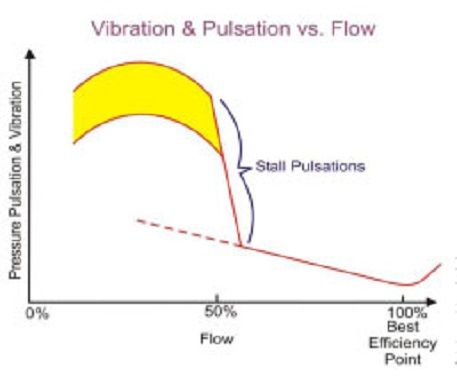Operating a pump away from its BFP
It is always recommended to select a pump which will typically operate close to its Best Efficiency Point (“BEP”). Contrary to intuition, centrifugal pumps do not undergo less nozzle loading and vibration as they are throttled back, unless the throttling is accomplished by variable speed operation.
This article reproduces an excerpt from William D. Marscher, President & Technical Director Mechanical Solutions, Inc., at the 2016 Turbomachinery and Pump Symposium.
Operation well below the BEP at any given speed, just like operation well above that point, causes a mismatch in flow incidence angles in the impeller vanes and the diffuser vanes or volute tongues of the various stages. This loads up the vanes, and may even lead to “airfoil stalling”, with associated formation of strong vortices (miniature tornadoes) that can severely shake the entire rotor system at subsynchronous frequencies (which can result in vibration which is high, but not unbounded like a rotor instability), and can even lead to fatigue of impeller shrouds or diffuser annular walls or “strong-backs”.

Fig 1. Effect on Vibration on Off-BEP Operation[/caption]
The rotor impeller steady side-loads and shaking occurs at flows below the onset of suction or discharge recirculation. The typical effect on rotor vibration of the operation of a pump at off-design flows is shown in Fig. 1. If a plant must run a pump away from its BEP because of an emergency situation, plant economics, or other operational constraints, at least never run a pump for extended periods at flows below the “minimum continuous flow” provided by the manufacturer. Also, if this flow was specified prior to about 1985, it may be based only on avoidance of high temperature flashing (based on temperature build-up from the energy being repeatedly added to the continuously recirculating processed flow) and not on recirculation onset which normally occurs at higher flows than flashing, and should be re-checked with the manufacturer.